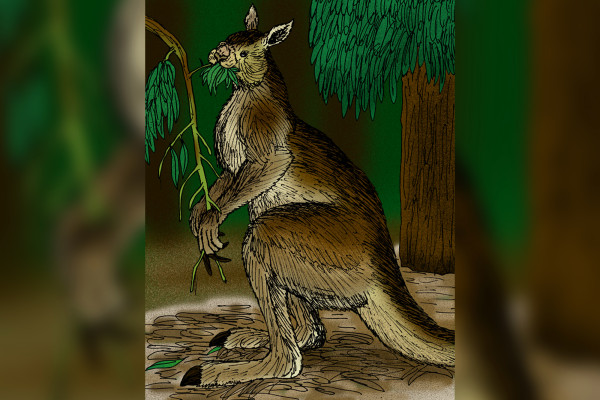研究表明,澳大利亚大量动物死于人类和气候变化
研究表明,澳大利亚大量动物死于人类和气候变化
Nearly 42,000 years ago, massive animals such as 6-foot-tall birds, 23-foot long lizards and wombat-like creatures the size of a Buick could be seen roaming the countryside. But a new study has found that these megafaunas became extinct because of human intervention and climate change.
大约4万2千年前,人们可以看到6英尺高的鸟、23英尺长的蜥蜴以及别克大小的袋熊等大型动物在乡间漫步。但一项新的研究发现,由于人类的干预和气候变化,这些巨型动物已经灭绝。
The researchers, led by Dr. Frederik Saltre of Flinders University, used a variety of techniques to find human migration patterns in Australia.
弗林德斯大学(Flinders University)的弗雷德里克·萨特博士(Dr. Frederik Saltre)领导的研究人员使用多种技术,在澳大利亚发现了人类迁徙模式。
“We developed a complex mathematical technique to solve the problems of averaging timelines over landscapes,” he told Fox News. “Our approach extends the information provided by radiocarbon-dated fossils from the extinct species themselves, and archaeological evidence from early Aboriginal people, [and] this way we can create unbiased maps of both the timings of megafauna extinctions and human arrival across the landscape.”
“我们开发了一种复杂的数学技术来解决在地形上平均时间线的问题,”他告诉福克斯新闻。“我们的方法扩展了已灭绝物种的放射性碳年代化石所提供的信息,以及早期原住民的考古证据,(而且)通过这种方式,我们可以创建无偏倚的地图,既反映了巨型动物灭绝的时间,也反映了人类到达这片土地的时间。”

Based on these new maps, the team of researchers was able to estimate the regions where humans and megafauna coexisted (for example, New South Wales and north of South Australia), and where they did not (south of Victoria, Tasmania, etc.).
根据这些新的地图,研究小组能够估计出人类和巨型动物共存的区域(例如,新南威尔士州和南澳大利亚州的北部),以及它们不共存的区域(维多利亚州南部、塔斯马尼亚州等)。
“We then used sophisticated spatial computer models to analyze what conditions – changing temperature, precipitation, freshwater availability, proportion of desert, plant coverage, and the arrival of people – best explained the timing of megafauna extinctions across the landscape,” Saltre added.
“然后,我们使用复杂的空间计算机模型来分析什么条件——不断变化的温度、降水、淡水可用性、沙漠比例、植物覆盖范围和人类的到来——能够最好地解释整个景观中巨型动物灭绝的时间,”Saltre补充说。
With most of Australia being arid, freshwater was a high priority for megafauna and humans, with its availability being one of the main reasons for people’s migration patterns. Humans and megafauna would inevitably interact at watering holes, leaving the giant animals vulnerable to hunting, further dwindling their numbers.
由于澳大利亚大部分地区干旱,淡水是大型动物和人类的优先选择,淡水的可获得性是人们迁移模式的主要原因之一。人类和巨型动物不可避免地会在水坑里相互作用,使得这些巨型动物很容易被捕猎,从而进一步减少它们的数量。
Saltre, unlike today, these ancient humans did not have an impact on the big dry-out.
Saltre表示,与如今不同,这些古代人类对大干旱没有影响。
“In regions like Tasmania and south of South Australia and Victoria, humans never coexisted with megafauna because they migrated across these areas after the megafauna had already gone extinct,” he explained. “This rules humans out as the likely driver of megafauna extinction in those regions only, but a closer look at climate change during this extinction event in these areas showed that megafauna species might have suffered from a lack of food availability in the form of plants — most of the species that went extinct were plant-eaters.”
他解释说:“在塔斯马尼亚、南澳大利亚南部和维多利亚州等地区,人类从未与巨型动物共存过,因为它们是在巨型动物灭绝后才迁徙到这些地区的。””这个规则,人类只可能在这些地区司机巨型动物的灭绝,但仔细看看气候变化在这些领域在这灭绝事件表明,巨型动物物种可能遭受缺乏食物可用性植物的形式——大部分的物种灭绝是食草动物。”
So why was the role of humans in the demise of the Australian megafauna so heavily debated over the years? According to Saltre, up until now, the main ways researchers looked into the causes of megafauna extinction were to build timelines of major events: when the species went extinct; when people arrived; and when the climate changed.
那么,为什么人类在澳大利亚巨型动物的灭绝中所扮演的角色多年来一直备受争议呢?根据萨特的说法,到目前为止,研究人员研究巨型动物灭绝原因的主要方法是建立重大事件的时间轴:物种何时灭绝——有人类到达——气候变化。
However, because there are so few fossilized animal specimens in Australia due to the continent’s harsh conditions, reliable data is scarce. Some studies have been restricted to making conclusions at the scale of single paleontological sites, or of specific archaeological sites, while other studies have taken the opposite approach by including evidence from across the entire continent.
然而,由于澳大利亚大陆的恶劣环境,动物化石标本非常少,可靠的数据很少。一些研究仅限于在单个古生物遗址或特定考古遗址的规模上得出结论,而另一些研究采取了相反的方法,包括来自整个大陆的证据。
“Unfortunately, this ‘lumping’ of the available evidence across many different sites ignores the fact that different conditions might be causing extinctions in different combinations depending on where you are in the landscape,” Saltre said.
“不幸的是,这种对许多不同地点现有证据的‘集中’忽略了一个事实,即不同的环境可能会导致不同的物种灭绝,具体情况取决于你在景观中的位置,”Saltre说。
He continued: “This is like either having too few pieces of a jigsaw puzzle to be able to see the big picture (single sites), or being able to see the big picture, but only a fuzzy, pixelated version of it (landscape averaging). Our new approach takes the best of both worlds, because we have now access to all the pieces of the puzzle to unveil the big picture at a good resolution.”
他继续说:“这就像要么是拼图的碎片太少,无法看到大的图片(单个网站),要么是只能看到大的图片,但只有一个模糊的,像素化的版本(风景平均)。我们的新方法是两全其美,因为我们现在可以接触到所有的拼图碎片,从而以一个良好的解决方案来揭开大的图景。”
The study can be found in Nature Communications.
这项研究发表在《自然通讯》杂志上。


















